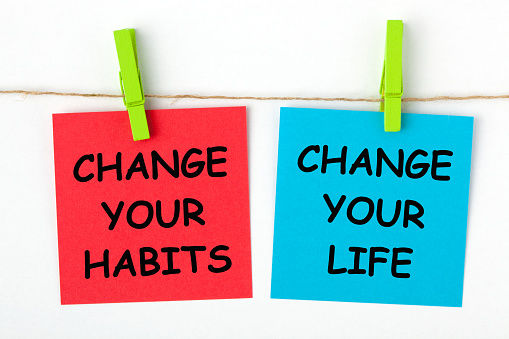
Change is difficulty for many of us, especially when we are trying to change something that we really enjoy or that gives us pleasure. To achieve the goal of eating healthier you may need to change some of your habits as we discussed in Part 2 of this series, but you may also have to change some things in your environment. You really don’t need to make huge changes to eat healthier, and you do not need to change everything at once. It is actually better to make small goals and to change your habits a little bit at a time. Over time, those small changes can make a big difference in your health.
I would suggest choosing one thing to work on changing now. Then, as that one thing is less intimidating and working better for you, acknowledge that you are succeeding and your efforts are paying off- give yourself a pat on the back and add another simple change to your lifestyle.
My suggestions for potential changes to try over a period of time:

· Slow down and chew more. The pace that we eat at influences how much you eat, as well as how likely you are to gain weight. Our appetite is controlled by hormone signals to the brain of hungry or full. These signals take about 20 minutes to get to the brain, so if we slow down our pace for eating and chew our food more (making it easier to digest as well) then we are likely to be able to actually stop when we are feeling full and not over eat.
· Keep more fruits, low-fat dairy products, vegetables, and whole-grain foods at home and at work. Focus on adding healthy options rather than just taking unhealthy foods away from your diet.
· Plan your meals. Meal planning can help people to have a healthier diet and may even help them to experience less obesity. Taking the time to plan your meals for the entire week allows you to give yourself plenty of variety, maintain a proper balance and create a shopping list for (hopefully) one trip to the grocery store. One last benefit- if you are cooking for the week ahead, like some people do, you are able to control the portion size as well.

· Try to avoid eating in front of the TV. Your meal should be enjoyed, while we are eating in front of the TV, we are distracted and tend to consume more calories than if we are more mindful of what and how much we are eating.
· Drink water often. You can also choose flavored water, seltzer water, unsweetened coffee or tea, and 100% fruit juice in moderation. Water has been shown to increase weight loss and promote weight maintenance. Drinking water before your meals can reduce your appetite and therefore your food intake as well.
· Prepare fruit and vegetable snacks to ensure you are consuming the recommended amounts and also to ensure you are not going to grab that sugary candy or caffein-laden drink at your mid-afternoon slump. You can have sliced fruit, carrots (with hummus 😊), dried or freeze-dried fruit for on the go for some suggestions.
Also having some vegetables prepped and pre-sliced for easily grabbing them to incorporate them into dinner prep.

· Try to not eat the same foods repetitively. Remember variety is key for a healthy diet. If we are eating a wide variety of foods then we are ensuring that we are getting different nutrients and reducing the risk of metabolic syndrome (a cluster of conditions that increase the risk of heart disease, stroke and diabetes). A suggestion is to “eat the rainbow” where it is recommended to consume foods that naturally come in a wide variety of colors.
· Skip the diet soda, it may contain less sugar than regular soda, but there are added chemicals that are being linked to other health problems.
· Limit fried foods. Opt instead for air-frying or baking your dishes instead.

· Don’t skip breakfast. We have all heard that breakfast is the most important meal of the day, research is showing that breakfast skippers consume significantly more calories, carbs, total and saturated fats and added sugars during lunch, dinner and snacks that breakfast eaters do. Also breakfast is often linked to greater intake of many nutrients including folate, calcium and iron.
· Put your snacks on a plate instead of eating out of the package, this helps you to control what you are eating. Also eating your meals on a smaller plate helps you to control your portion size.
· Try eating vegetables at breakfast for more fiber to keep you feeling fuller longer and snacking less. You can cut one egg out of your omelet and add cooked spinach, mushrooms, onions or peppers instead, or make a smoothie with kale, apples, bananas, and yogurt.

· Try herbs and spices instead of reaching for the salt shaker during food prep. Herbs and spices are sodium-free but pack a punch in the flavor department!
· Replace your favorite fast-food restaurant. Eating out does not have to involve unhealthy food. You can upgrade your favorite burger or pizza joint to a fusion kitchen or a healthier choice fast food restaurant to get that quick and delicious meal.
· Focus on the positive. As you are building healthy eating habits, find things that you can add to your diet- seek out and try the fruit or vegetable that you never had. You are more likely to stay on track when you embrace what you can have instead of dwelling on things that you want to limit.
I hope that this inspires you with ideas for some simple and effective lifestyle changes that could make a dramatic difference for you. A few small changes now could affect not only your waistline, but how you feel, how much energy you have, what your overall health is like and what your mood is like for years to come.
References: Coleman, E. (2011) Diet, Exercise and Fitness. Nutrition Dimension Inc.
Kline, D. and Coleman, E. (2008) Practical Nutrition for Fitness Professionals. Nutrition Dimension Inc.
Next time:

Stay tuned for my next blog in 2 weeks for Self-Love, where we discuss practicing Self-Love and learn tips to being good to yourself.
Related Post Links: Healthy Eating Part 1:
Healthy Eating Part 2:
Author: Jen Hassaj | 2-8-23



Comments